Would you like to go on a highlight tour of the MET?
I truly enjoy @delishtreats tours of the beautiful countryside and castles of Europe. Tours are so great because you get to learn so much. Today I am going to take you with me to New York City and one of the best museums in the world...The Metropolitan Museum of Art or the MET.
During your 9-10 minute read you will get to travel through time, from 4th century BC to 2011 and visit Greece, The Republic of Congo, France, Italy, Spain and Japan.
Are you ready? Comments and questions along the way are encouraged.
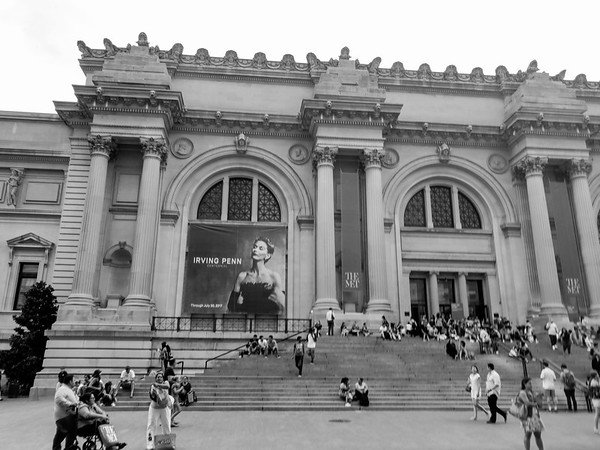
We will start our tour on the first floor in Ancient Greece.

Marble statue of a woman
Artist Unknown, 4th Century BC, Marble
This marble statue is dated 2nd half of the 4th century B.C, which is the classical era.
To give some context, the most important political events were the conquest of Alexander the Great, bringing down the Persian Empire. During this time the Romans built the first aqueduct and Aristotle was born in 384 B.C.
The figure is larger than life size and probably a goddess.
The most impressive part to me, is the detail and how fluid the cloth or tunic is that she wearing looks. There are two different pieces of cloth the one that is covering her body (chiton). This part of her tunic is made to look almost transparent, like and very fine linen. The other piece (himation) she has wrapped around her waist and arm and the artist made look like a heavier material such as wool.
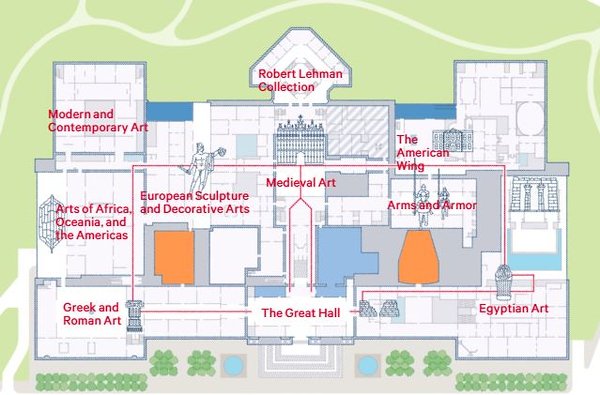
Map of the MET, 1st Floor
Now we are moving going to move from the Greek and Roman Art and into the Arts of Africa, Oceania and the Americas and look at and talk about a striking power figure from Africa.
As we moved from one room to another we went from the late 4th century to the 19th century and from Greece to the Republic of Congo in Africa.
Where the Greek statue was made of marble this is a mixed media piece made of wood, iron, resin, ceramic, plant fiber, textile and pigment.
This is quite a fascinating piece of art work. The Mangaaka figure is around four feet tall and was carved from a single piece of wood. The figure was "activated" and then used by a priest who would insert sacred materials into the body, this piece has 380 pieces embedded into it. The priest did this to finalize treaties, record transactions or settle disputes. Each of the pieces of metal in the figure represent one of the interventions by the priest.
The Kongo civilization did not survive long into the 20th century. We are very fortunate to have some of these power figures and learn more about the people that made and used them.
4 and 5

Power Figure (Nkisi N'Kondi: Mangaaka)
Artist Unknown, 19th Century, Wood and mixed media

Now let's head to the European Sculpture and Decorative Arts area of the museum. This is one of my very favorite areas. The sunlight coming through the skylights makes my heart happy.

European Sculpture and Decorative Arts Hall

The Burghers of Calais, Detail of Jean d'Aire
Auguste Rodin, 1884-1895, Bronze
The Burghers of Calais is the the bronze that we are going to focus on in this area.
I keep seeing and interacting with the this statue to whether in New York City at the MET or in DC at the Hirshhorn or in San Francisco at Stanford University. It is a moving piece about six men of Calais, France that gave themselves up for the city. Rodin sculpted the moment in time of the men as they departed the city, each man with his own emotion of what his sacrifice would mean for him and those he loved. Although though they thought they were going to be executed, their lives would be spared.
The one that I captured in the picture on the right is Jean d'Aire. What would you be thinking? Who would you be thinking about?
6 and 7

Now we will head up to the 2nd floor and our first stop will be in the European Paintings, 1250-1800 to gallery 638.
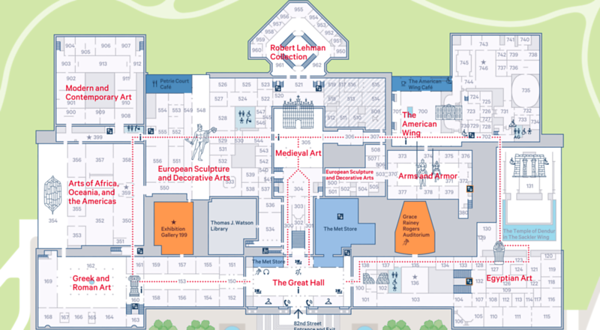
Map of the MET, 2nd Floor

Venus and Adonis
Titian, 1560s, Oil on canvas
Have you heard the term "poesie"? It is what Titian calls poetry in paint. What a wonderful thing to imagine. Poetry in Paint.
Ovid’s Metamorphoses inspired this painting. The story goes that Venus was accidentally pricked by one Cupid's, her son, arrows and has fallen in love with Adonis and here she is is holding him to her not wanting him to go on the hunt. 8

Now we are going to the Robert Lehman Collection to see a painter that worked in Titian's workshop in Italy.
El Greco or The Greek was born in Crete, Greece in 1541. By the 1560s he had moved to Italy and was painting in Titian's workshop. Not able to get commissions he moved to Toledo, Spain where he spent the last 40 years of his life.
During the 1500s most of the art done was commissioned by the church and was therefore of religious subjects. Although this picture does show the church it is a landscape picture and considered the first Spanish landscape.
El Greco also took the liberty to move some of the buildings around, he wasn't documenting the city but rather what the city feels like. What does it feel like to you? Do cities have certain feelings to you? They do to me. 9
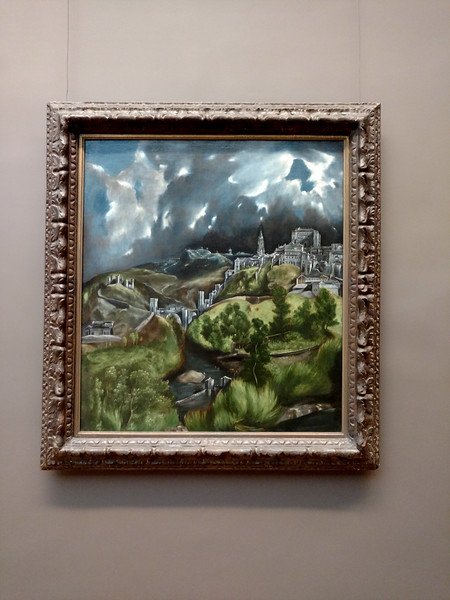
View of Toldeo
El Greco, 1599-1600, Oil on Canvas

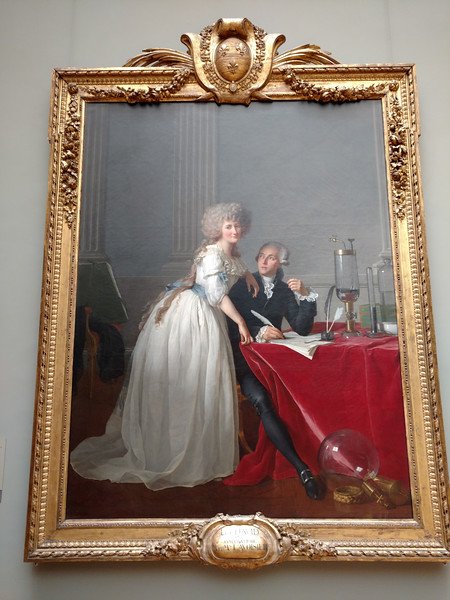
Jacques Louis David, 1788, Oil on Canvas
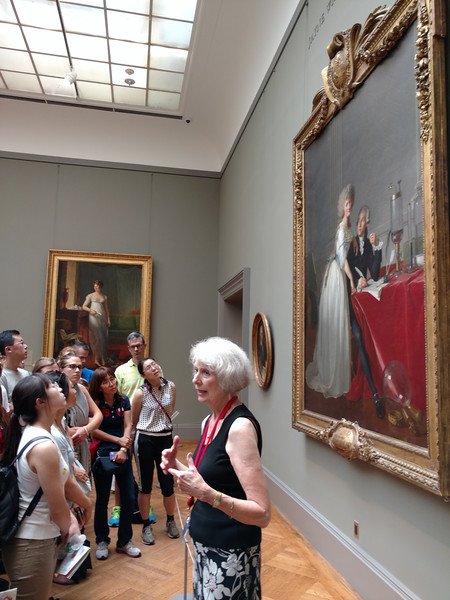
The tour guide talking about this beautiful double portrait
We will head out of the Robert Lehman Collection and back into the European Paintings, 1250-1800 to gallery 629 and see Antoine Laurent Lavoisier and His Wife Marie Anne Pierrette Paulze one of the paintings I found most interesting because of the people in it.
Antoine-Laurent was a renown scientist and became famous for being the first person to succeed in determining the composition of water. He also pioneered studies in gunpowder and oxygen. His with Marie Anne was also a chemist and helped him in the lab and translated several scientific works for him. She also took art lessons from Jacques Louis David and illustrated a textbook for her husband, Antione-Laurent.
David shows both the interest Monsieur and his wife have in chemistry and his immense skill as an artist by placing different glass instruments in the picture. David also was skilled at painting textiles, look at the cotton in her dress and the velvet of the table cloth. Truly it is one of my favorite pictures on the tour and next time I go to the MET I must see it again.
The year this was painted was 1788. It is a portrait of a beautiful, affectionate, and intelligent couple. In 5 years Antoine-Laurent would be guillotined in the reign of Terror. 10 and 11

Now we move through time (223 years) and space (over 6,000 miles) from David's France to Kohei Nawa's Japan.
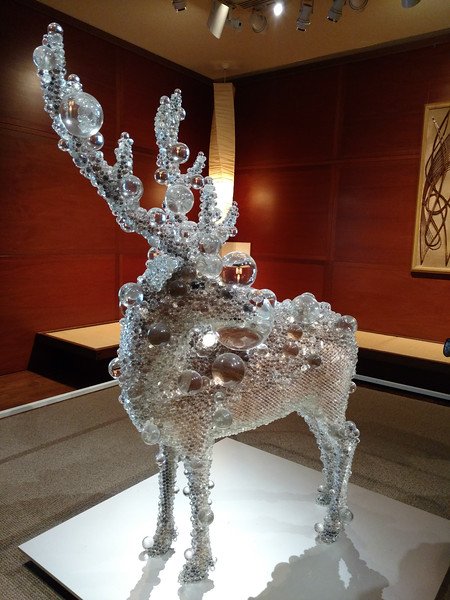
PixCell-Deer#24
Kohei Nawa, 2011, Mixed Media
(taxidermied deer with artificial crystal glass)
When I first walked into the room I couldn't figure out what I was looking at. Then the tour guide said something about a deer. Ok, I could see a deer... kinda. What was all the glass? It really was such a strange experience to know and recognize the shape of the deer and to be so thrown off by the glass all over it.
Kohei Nawa has a whole series called PixCell in which he covered many different objects, mostly taxidermy animals.
Of PixCell Nawa said,
To our senses of vision and touch, the world is a continuum of surfaces, and all things are covered with some sort of skin. Because we sense and become aware of objects through their skin, it is the quality of the skin that determines whether or not we feel something to be real. The skin becomes an interface that links sensibility with matter, and images are produced through this interplay of sensibility and matter."
Hope you have enjoyed this tour of the MET. There are so many incredible works of art (over 2 Million in the permanent collection) housed in this incredible building in New York City on the edge of Central Park and we only looked at 7 of the pieces. 14
What did you think? Are you a museum person? Do you go on the tours offered when you go to museums?

Sources
1 MET collection: Marble Statue of a woman
2 4th century BC
3 Aristotle
4 MET collection: Power Figure (Nkisi N'Kondi: Mangaaka)
5 New York Times Kongo Power Figure
6 MET collection:The Burghers of Calais
7 Khan Academy: The Burghers of Calais
8 MET collection: Venus and Adonis
9 Khan Academy:The View of Toledo
10 MET collection: Antoine Laurent Lavoiser and His Wife
11 Wikipedia: Marie-Anne Paulze Lavoisier
12 MET collection: PixCell-Deer#24
13 Digicult: Kohei Nawa
14 Wikipedia: Metropolitan Museum of Art
Art Talk Series Highlights
Art Talk: Introduction
Art Talk: Emotion In Bronze
Art Talk: Moore in America
Art Talk: Art Tells Our Story
